MERCEDES-BENZ SPRINTER 2005 Service Repair Manual
Manufacturer: MERCEDES-BENZ, Model Year: 2005, Model line: SPRINTER, Model: MERCEDES-BENZ SPRINTER 2005Pages: 1232, PDF Size: 39.23 MB
Page 1111 of 1232
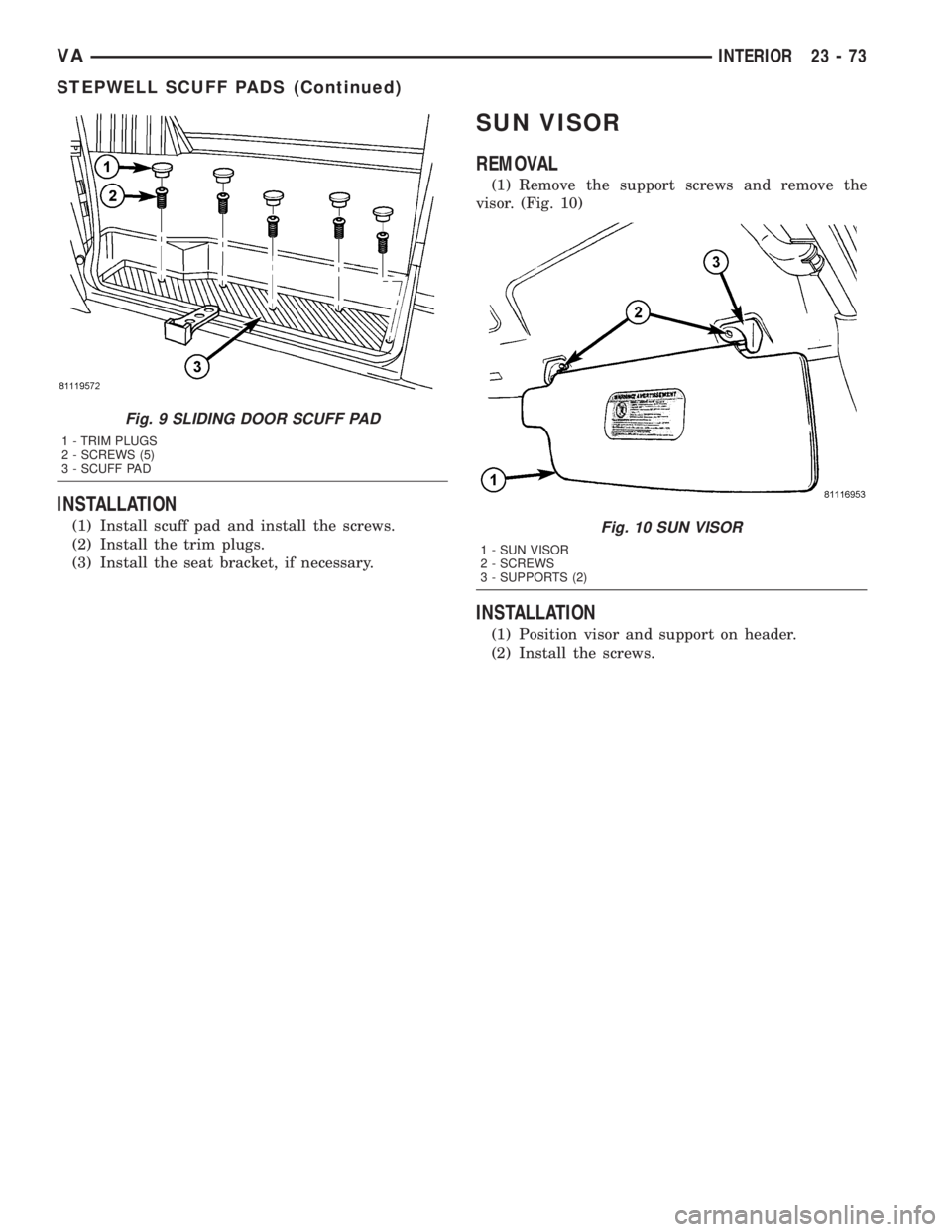
INSTALLATION
(1) Install scuff pad and install the screws.
(2) Install the trim plugs.
(3) Install the seat bracket, if necessary.
SUN VISOR
REMOVAL
(1) Remove the support screws and remove the
visor. (Fig. 10)
INSTALLATION
(1) Position visor and support on header.
(2) Install the screws.
Fig. 9 SLIDING DOOR SCUFF PAD
1 - TRIM PLUGS
2 - SCREWS (5)
3 - SCUFF PAD
Fig. 10 SUN VISOR
1 - SUN VISOR
2 - SCREWS
3 - SUPPORTS (2)
VAINTERIOR 23 - 73
STEPWELL SCUFF PADS (Continued)
Page 1112 of 1232
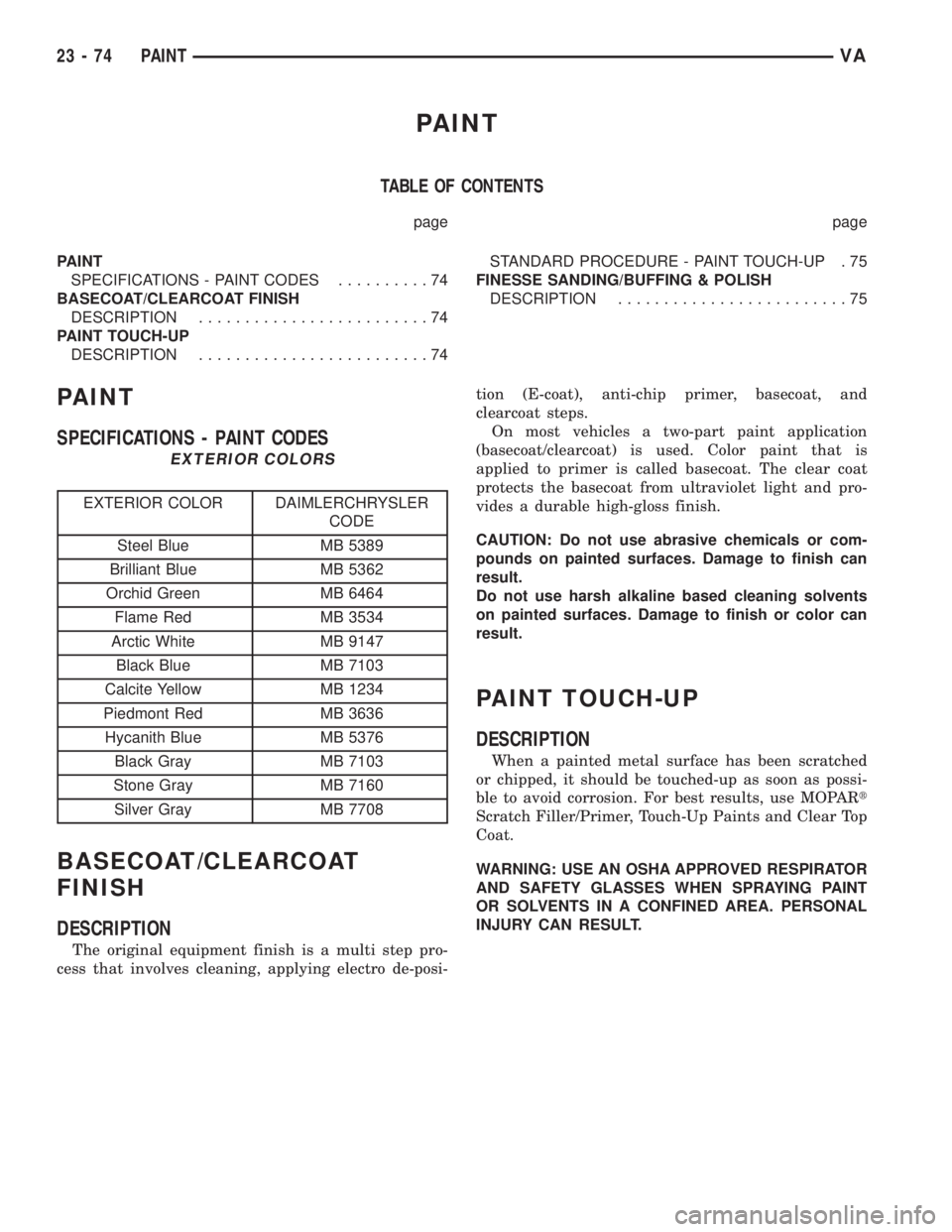
PAINT
TABLE OF CONTENTS
page page
PAINT
SPECIFICATIONS - PAINT CODES..........74
BASECOAT/CLEARCOAT FINISH
DESCRIPTION.........................74
PAINT TOUCH-UP
DESCRIPTION.........................74STANDARD PROCEDURE - PAINT TOUCH-UP . 75
FINESSE SANDING/BUFFING & POLISH
DESCRIPTION.........................75
PAINT
SPECIFICATIONS - PAINT CODES
EXTERIOR COLORS
EXTERIOR COLOR DAIMLERCHRYSLER
CODE
Steel Blue MB 5389
Brilliant Blue MB 5362
Orchid Green MB 6464
Flame Red MB 3534
Arctic White MB 9147
Black Blue MB 7103
Calcite Yellow MB 1234
Piedmont Red MB 3636
Hycanith Blue MB 5376
Black Gray MB 7103
Stone Gray MB 7160
Silver Gray MB 7708
BASECOAT/CLEARCOAT
FINISH
DESCRIPTION
The original equipment finish is a multi step pro-
cess that involves cleaning, applying electro de-posi-tion (E-coat), anti-chip primer, basecoat, and
clearcoat steps.
On most vehicles a two-part paint application
(basecoat/clearcoat) is used. Color paint that is
applied to primer is called basecoat. The clear coat
protects the basecoat from ultraviolet light and pro-
vides a durable high-gloss finish.
CAUTION: Do not use abrasive chemicals or com-
pounds on painted surfaces. Damage to finish can
result.
Do not use harsh alkaline based cleaning solvents
on painted surfaces. Damage to finish or color can
result.
PAINT TOUCH-UP
DESCRIPTION
When a painted metal surface has been scratched
or chipped, it should be touched-up as soon as possi-
ble to avoid corrosion. For best results, use MOPARt
Scratch Filler/Primer, Touch-Up Paints and Clear Top
Coat.
WARNING: USE AN OSHA APPROVED RESPIRATOR
AND SAFETY GLASSES WHEN SPRAYING PAINT
OR SOLVENTS IN A CONFINED AREA. PERSONAL
INJURY CAN RESULT.
23 - 74 PAINTVA
Page 1113 of 1232
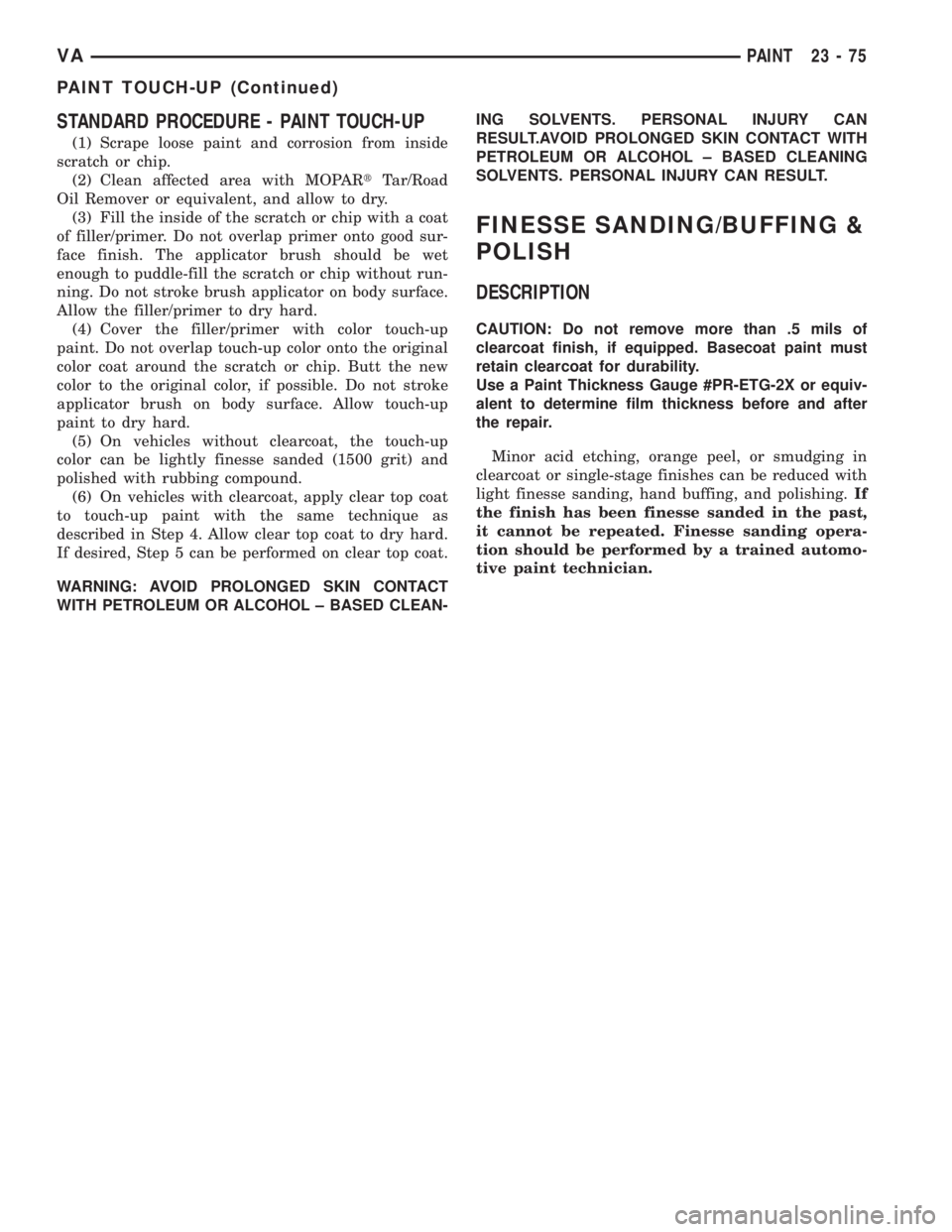
STANDARD PROCEDURE - PAINT TOUCH-UP
(1) Scrape loose paint and corrosion from inside
scratch or chip.
(2) Clean affected area with MOPARtTar/Road
Oil Remover or equivalent, and allow to dry.
(3) Fill the inside of the scratch or chip with a coat
of filler/primer. Do not overlap primer onto good sur-
face finish. The applicator brush should be wet
enough to puddle-fill the scratch or chip without run-
ning. Do not stroke brush applicator on body surface.
Allow the filler/primer to dry hard.
(4) Cover the filler/primer with color touch-up
paint. Do not overlap touch-up color onto the original
color coat around the scratch or chip. Butt the new
color to the original color, if possible. Do not stroke
applicator brush on body surface. Allow touch-up
paint to dry hard.
(5) On vehicles without clearcoat, the touch-up
color can be lightly finesse sanded (1500 grit) and
polished with rubbing compound.
(6) On vehicles with clearcoat, apply clear top coat
to touch-up paint with the same technique as
described in Step 4. Allow clear top coat to dry hard.
If desired, Step 5 can be performed on clear top coat.
WARNING: AVOID PROLONGED SKIN CONTACT
WITH PETROLEUM OR ALCOHOL ± BASED CLEAN-ING SOLVENTS. PERSONAL INJURY CAN
RESULT.AVOID PROLONGED SKIN CONTACT WITH
PETROLEUM OR ALCOHOL ± BASED CLEANING
SOLVENTS. PERSONAL INJURY CAN RESULT.
FINESSE SANDING/BUFFING &
POLISH
DESCRIPTION
CAUTION: Do not remove more than .5 mils of
clearcoat finish, if equipped. Basecoat paint must
retain clearcoat for durability.
Use a Paint Thickness Gauge #PR-ETG-2X or equiv-
alent to determine film thickness before and after
the repair.
Minor acid etching, orange peel, or smudging in
clearcoat or single-stage finishes can be reduced with
light finesse sanding, hand buffing, and polishing.If
the finish has been finesse sanded in the past,
it cannot be repeated. Finesse sanding opera-
tion should be performed by a trained automo-
tive paint technician.
VAPAINT 23 - 75
PAINT TOUCH-UP (Continued)
Page 1114 of 1232
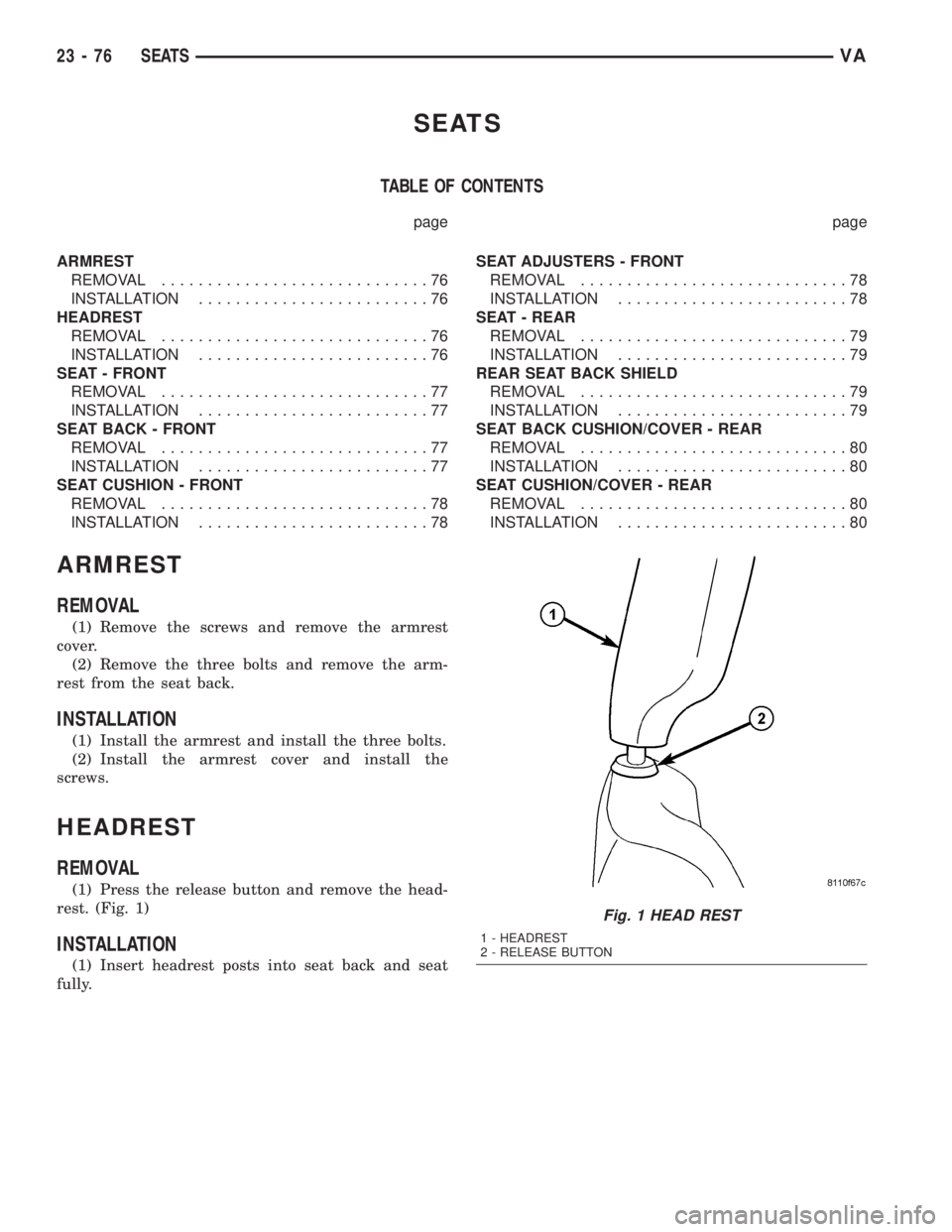
SEATS
TABLE OF CONTENTS
page page
ARMREST
REMOVAL.............................76
INSTALLATION.........................76
HEADREST
REMOVAL.............................76
INSTALLATION.........................76
SEAT - FRONT
REMOVAL.............................77
INSTALLATION.........................77
SEAT BACK - FRONT
REMOVAL.............................77
INSTALLATION.........................77
SEAT CUSHION - FRONT
REMOVAL.............................78
INSTALLATION.........................78SEAT ADJUSTERS - FRONT
REMOVAL.............................78
INSTALLATION.........................78
SEAT - REAR
REMOVAL.............................79
INSTALLATION.........................79
REAR SEAT BACK SHIELD
REMOVAL.............................79
INSTALLATION.........................79
SEAT BACK CUSHION/COVER - REAR
REMOVAL.............................80
INSTALLATION.........................80
SEAT CUSHION/COVER - REAR
REMOVAL.............................80
INSTALLATION.........................80
ARMREST
REMOVAL
(1) Remove the screws and remove the armrest
cover.
(2) Remove the three bolts and remove the arm-
rest from the seat back.
INSTALLATION
(1) Install the armrest and install the three bolts.
(2) Install the armrest cover and install the
screws.
HEADREST
REMOVAL
(1) Press the release button and remove the head-
rest. (Fig. 1)
INSTALLATION
(1) Insert headrest posts into seat back and seat
fully.
Fig. 1 HEAD REST
1 - HEADREST
2 - RELEASE BUTTON
23 - 76 SEATSVA
Page 1115 of 1232
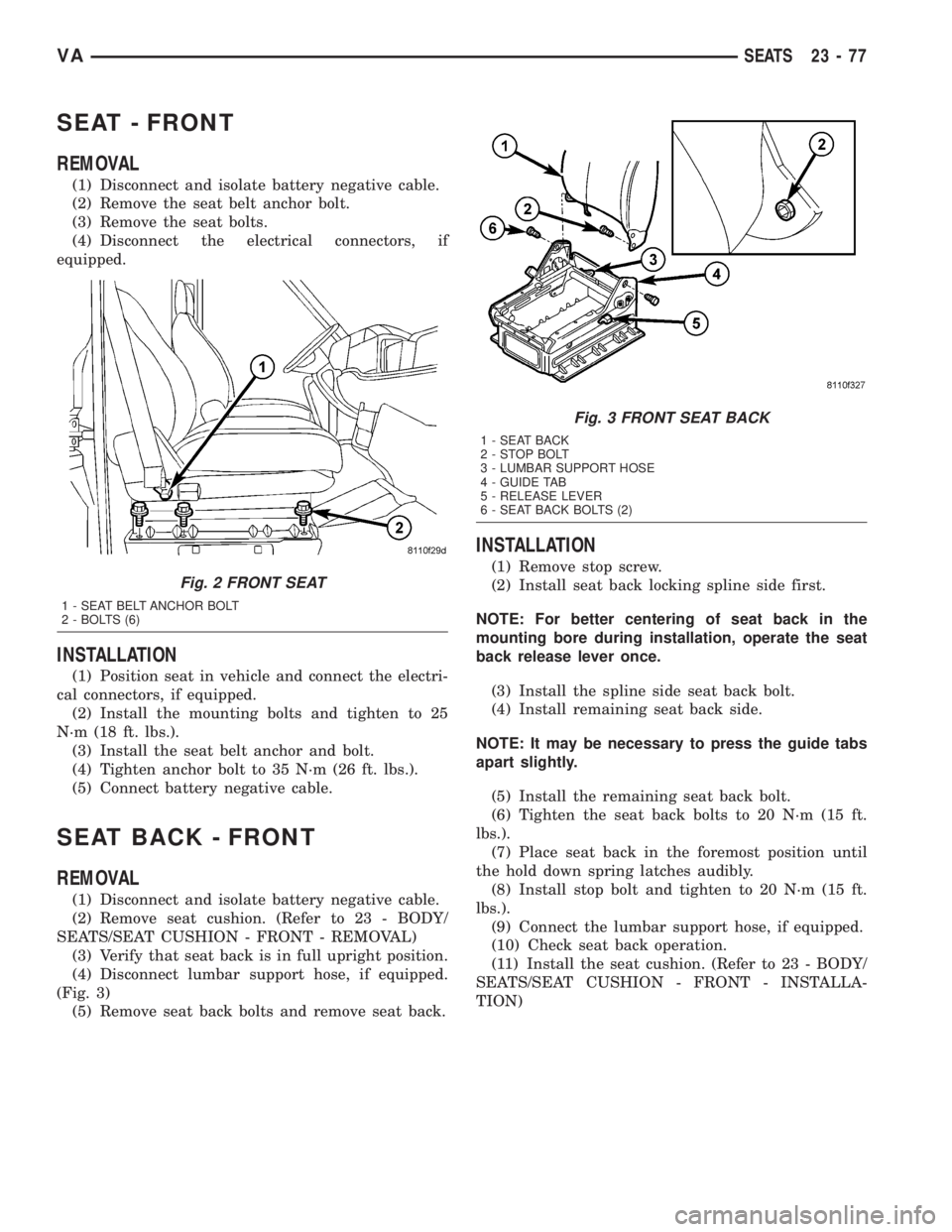
SEAT - FRONT
REMOVAL
(1) Disconnect and isolate battery negative cable.
(2) Remove the seat belt anchor bolt.
(3) Remove the seat bolts.
(4) Disconnect the electrical connectors, if
equipped.
INSTALLATION
(1) Position seat in vehicle and connect the electri-
cal connectors, if equipped.
(2) Install the mounting bolts and tighten to 25
N´m (18 ft. lbs.).
(3) Install the seat belt anchor and bolt.
(4) Tighten anchor bolt to 35 N´m (26 ft. lbs.).
(5) Connect battery negative cable.
SEAT BACK - FRONT
REMOVAL
(1) Disconnect and isolate battery negative cable.
(2) Remove seat cushion. (Refer to 23 - BODY/
SEATS/SEAT CUSHION - FRONT - REMOVAL)
(3) Verify that seat back is in full upright position.
(4) Disconnect lumbar support hose, if equipped.
(Fig. 3)
(5) Remove seat back bolts and remove seat back.
INSTALLATION
(1) Remove stop screw.
(2) Install seat back locking spline side first.
NOTE: For better centering of seat back in the
mounting bore during installation, operate the seat
back release lever once.
(3) Install the spline side seat back bolt.
(4) Install remaining seat back side.
NOTE: It may be necessary to press the guide tabs
apart slightly.
(5) Install the remaining seat back bolt.
(6) Tighten the seat back bolts to 20 N´m (15 ft.
lbs.).
(7) Place seat back in the foremost position until
the hold down spring latches audibly.
(8) Install stop bolt and tighten to 20 N´m (15 ft.
lbs.).
(9) Connect the lumbar support hose, if equipped.
(10) Check seat back operation.
(11) Install the seat cushion. (Refer to 23 - BODY/
SEATS/SEAT CUSHION - FRONT - INSTALLA-
TION)
Fig. 2 FRONT SEAT
1 - SEAT BELT ANCHOR BOLT
2 - BOLTS (6)
Fig. 3 FRONT SEAT BACK
1 - SEAT BACK
2 - STOP BOLT
3 - LUMBAR SUPPORT HOSE
4 - GUIDE TAB
5 - RELEASE LEVER
6 - SEAT BACK BOLTS (2)
VASEATS 23 - 77
Page 1116 of 1232
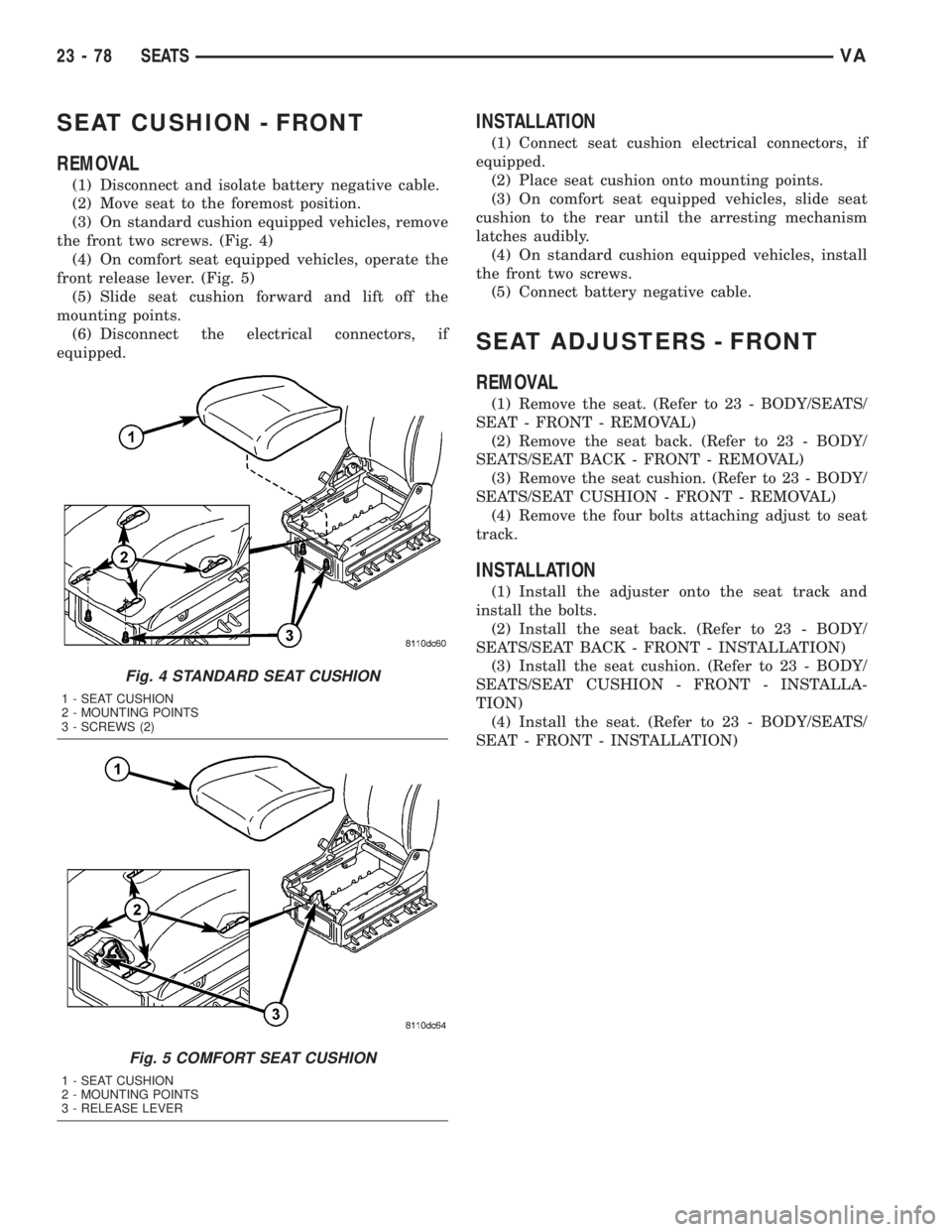
SEAT CUSHION - FRONT
REMOVAL
(1) Disconnect and isolate battery negative cable.
(2) Move seat to the foremost position.
(3) On standard cushion equipped vehicles, remove
the front two screws. (Fig. 4)
(4) On comfort seat equipped vehicles, operate the
front release lever. (Fig. 5)
(5) Slide seat cushion forward and lift off the
mounting points.
(6) Disconnect the electrical connectors, if
equipped.
INSTALLATION
(1) Connect seat cushion electrical connectors, if
equipped.
(2) Place seat cushion onto mounting points.
(3) On comfort seat equipped vehicles, slide seat
cushion to the rear until the arresting mechanism
latches audibly.
(4) On standard cushion equipped vehicles, install
the front two screws.
(5) Connect battery negative cable.
SEAT ADJUSTERS - FRONT
REMOVAL
(1) Remove the seat. (Refer to 23 - BODY/SEATS/
SEAT - FRONT - REMOVAL)
(2) Remove the seat back. (Refer to 23 - BODY/
SEATS/SEAT BACK - FRONT - REMOVAL)
(3) Remove the seat cushion. (Refer to 23 - BODY/
SEATS/SEAT CUSHION - FRONT - REMOVAL)
(4) Remove the four bolts attaching adjust to seat
track.
INSTALLATION
(1) Install the adjuster onto the seat track and
install the bolts.
(2) Install the seat back. (Refer to 23 - BODY/
SEATS/SEAT BACK - FRONT - INSTALLATION)
(3) Install the seat cushion. (Refer to 23 - BODY/
SEATS/SEAT CUSHION - FRONT - INSTALLA-
TION)
(4) Install the seat. (Refer to 23 - BODY/SEATS/
SEAT - FRONT - INSTALLATION)
Fig. 4 STANDARD SEAT CUSHION
1 - SEAT CUSHION
2 - MOUNTING POINTS
3 - SCREWS (2)
Fig. 5 COMFORT SEAT CUSHION
1 - SEAT CUSHION
2 - MOUNTING POINTS
3 - RELEASE LEVER
23 - 78 SEATSVA
Page 1117 of 1232
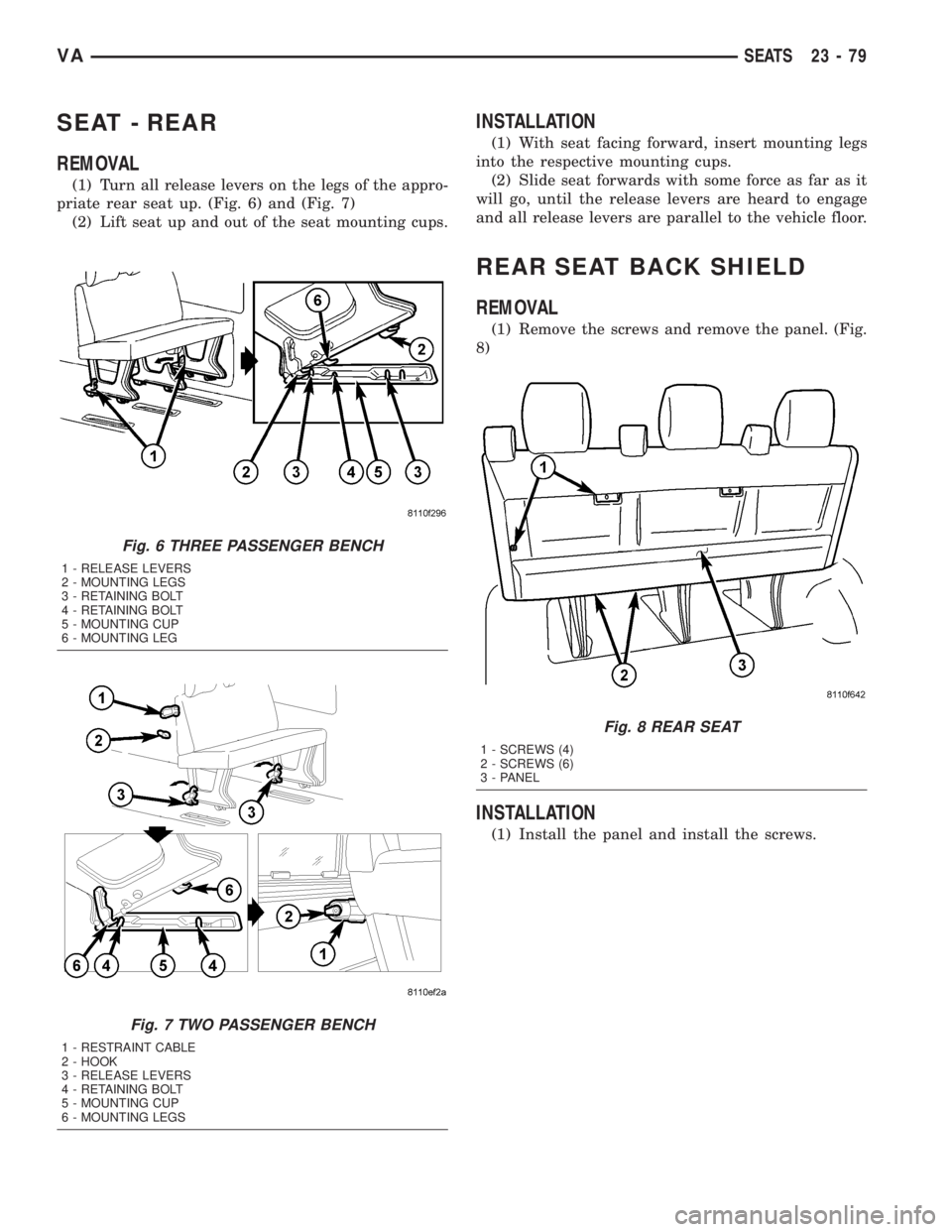
SEAT - REAR
REMOVAL
(1) Turn all release levers on the legs of the appro-
priate rear seat up. (Fig. 6) and (Fig. 7)
(2) Lift seat up and out of the seat mounting cups.
INSTALLATION
(1) With seat facing forward, insert mounting legs
into the respective mounting cups.
(2) Slide seat forwards with some force as far as it
will go, until the release levers are heard to engage
and all release levers are parallel to the vehicle floor.
REAR SEAT BACK SHIELD
REMOVAL
(1) Remove the screws and remove the panel. (Fig.
8)
INSTALLATION
(1) Install the panel and install the screws.
Fig. 6 THREE PASSENGER BENCH
1 - RELEASE LEVERS
2 - MOUNTING LEGS
3 - RETAINING BOLT
4 - RETAINING BOLT
5 - MOUNTING CUP
6 - MOUNTING LEG
Fig. 7 TWO PASSENGER BENCH
1 - RESTRAINT CABLE
2 - HOOK
3 - RELEASE LEVERS
4 - RETAINING BOLT
5 - MOUNTING CUP
6 - MOUNTING LEGS
Fig. 8 REAR SEAT
1 - SCREWS (4)
2 - SCREWS (6)
3 - PANEL
VASEATS 23 - 79
Page 1118 of 1232
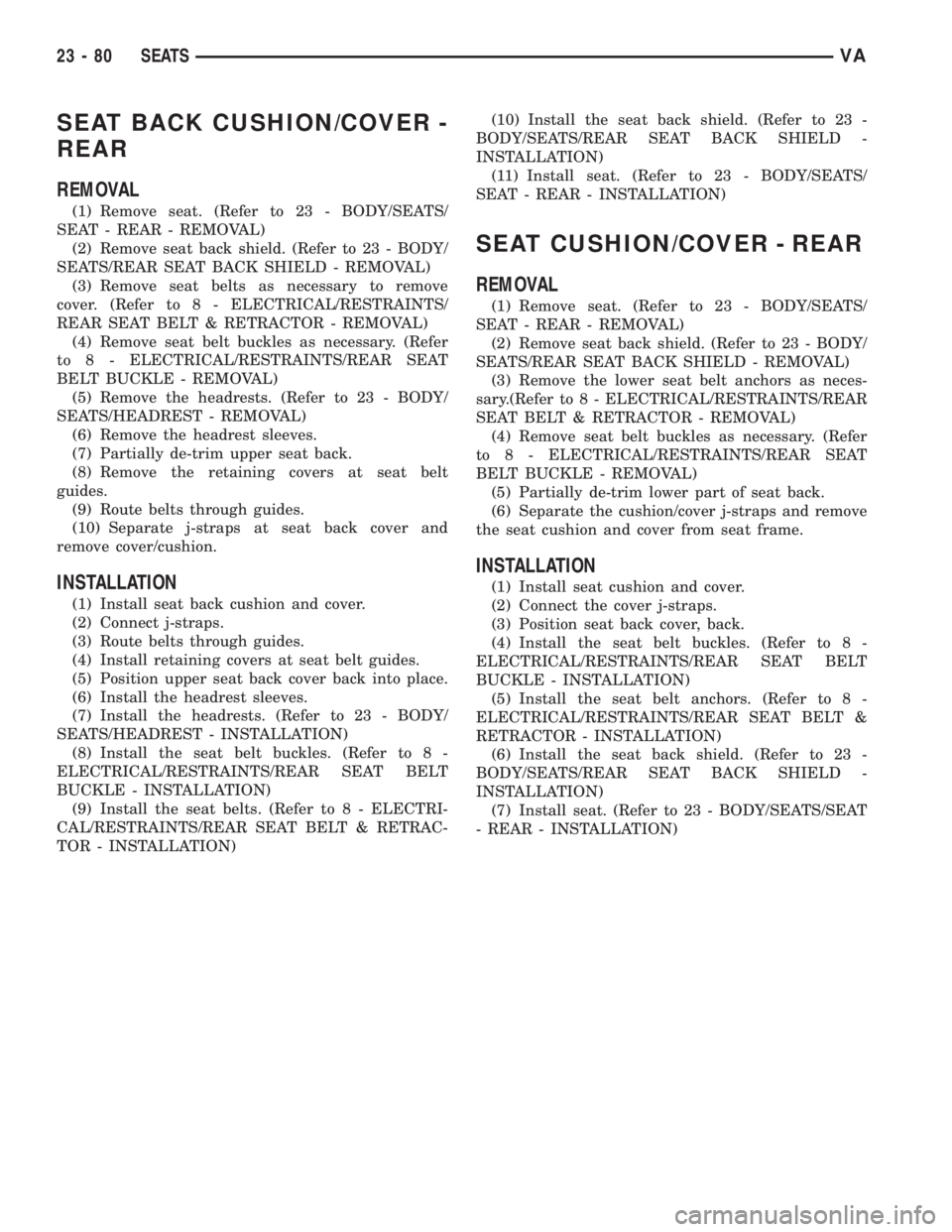
SEAT BACK CUSHION/COVER -
REAR
REMOVAL
(1) Remove seat. (Refer to 23 - BODY/SEATS/
SEAT - REAR - REMOVAL)
(2) Remove seat back shield. (Refer to 23 - BODY/
SEATS/REAR SEAT BACK SHIELD - REMOVAL)
(3) Remove seat belts as necessary to remove
cover. (Refer to 8 - ELECTRICAL/RESTRAINTS/
REAR SEAT BELT & RETRACTOR - REMOVAL)
(4) Remove seat belt buckles as necessary. (Refer
to 8 - ELECTRICAL/RESTRAINTS/REAR SEAT
BELT BUCKLE - REMOVAL)
(5) Remove the headrests. (Refer to 23 - BODY/
SEATS/HEADREST - REMOVAL)
(6) Remove the headrest sleeves.
(7) Partially de-trim upper seat back.
(8) Remove the retaining covers at seat belt
guides.
(9) Route belts through guides.
(10) Separate j-straps at seat back cover and
remove cover/cushion.
INSTALLATION
(1) Install seat back cushion and cover.
(2) Connect j-straps.
(3) Route belts through guides.
(4) Install retaining covers at seat belt guides.
(5) Position upper seat back cover back into place.
(6) Install the headrest sleeves.
(7) Install the headrests. (Refer to 23 - BODY/
SEATS/HEADREST - INSTALLATION)
(8) Install the seat belt buckles. (Refer to 8 -
ELECTRICAL/RESTRAINTS/REAR SEAT BELT
BUCKLE - INSTALLATION)
(9) Install the seat belts. (Refer to 8 - ELECTRI-
CAL/RESTRAINTS/REAR SEAT BELT & RETRAC-
TOR - INSTALLATION)(10) Install the seat back shield. (Refer to 23 -
BODY/SEATS/REAR SEAT BACK SHIELD -
INSTALLATION)
(11) Install seat. (Refer to 23 - BODY/SEATS/
SEAT - REAR - INSTALLATION)
SEAT CUSHION/COVER - REAR
REMOVAL
(1) Remove seat. (Refer to 23 - BODY/SEATS/
SEAT - REAR - REMOVAL)
(2) Remove seat back shield. (Refer to 23 - BODY/
SEATS/REAR SEAT BACK SHIELD - REMOVAL)
(3) Remove the lower seat belt anchors as neces-
sary.(Refer to 8 - ELECTRICAL/RESTRAINTS/REAR
SEAT BELT & RETRACTOR - REMOVAL)
(4) Remove seat belt buckles as necessary. (Refer
to 8 - ELECTRICAL/RESTRAINTS/REAR SEAT
BELT BUCKLE - REMOVAL)
(5) Partially de-trim lower part of seat back.
(6) Separate the cushion/cover j-straps and remove
the seat cushion and cover from seat frame.
INSTALLATION
(1) Install seat cushion and cover.
(2) Connect the cover j-straps.
(3) Position seat back cover, back.
(4) Install the seat belt buckles. (Refer to 8 -
ELECTRICAL/RESTRAINTS/REAR SEAT BELT
BUCKLE - INSTALLATION)
(5) Install the seat belt anchors. (Refer to 8 -
ELECTRICAL/RESTRAINTS/REAR SEAT BELT &
RETRACTOR - INSTALLATION)
(6) Install the seat back shield. (Refer to 23 -
BODY/SEATS/REAR SEAT BACK SHIELD -
INSTALLATION)
(7) Install seat. (Refer to 23 - BODY/SEATS/SEAT
- REAR - INSTALLATION)
23 - 80 SEATSVA
Page 1119 of 1232
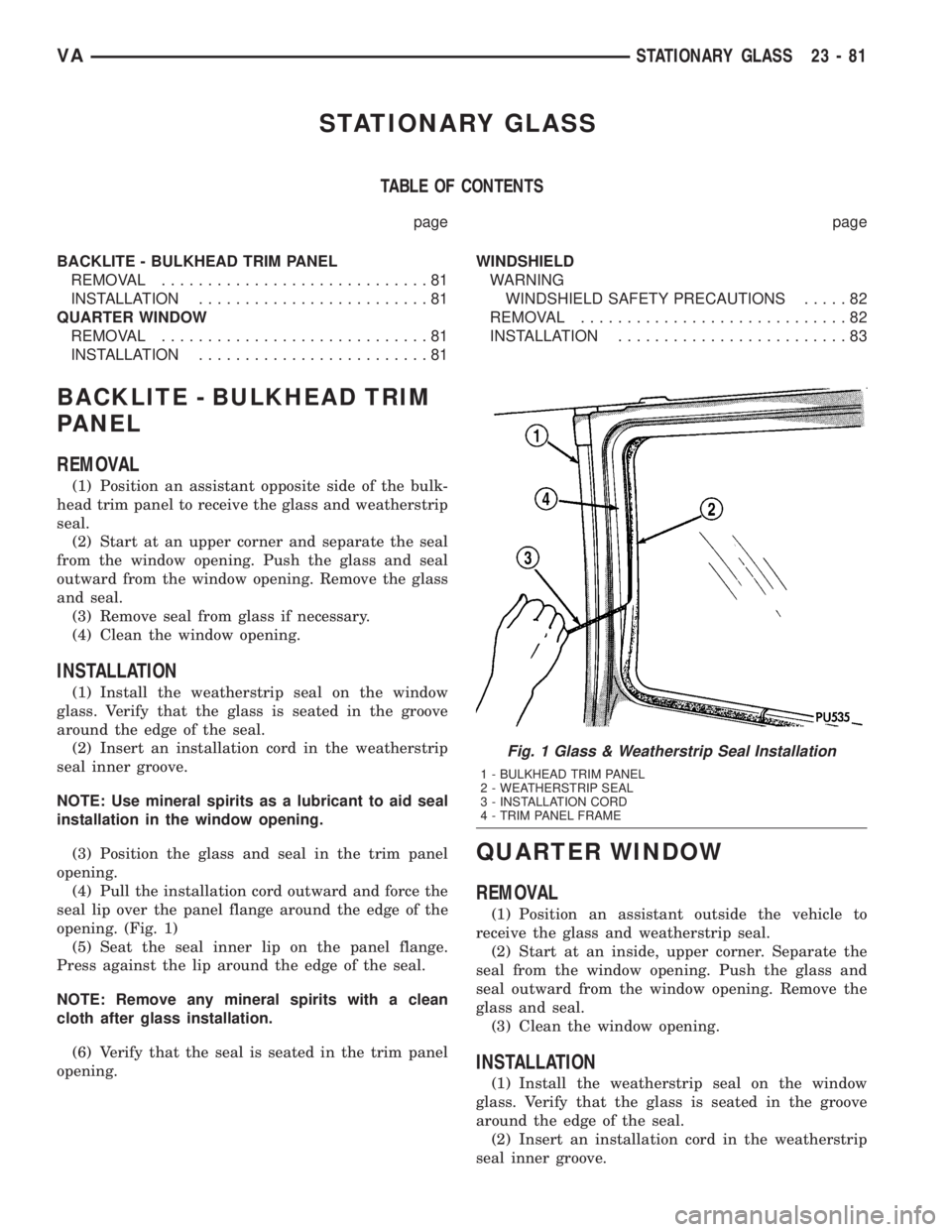
STATIONARY GLASS
TABLE OF CONTENTS
page page
BACKLITE - BULKHEAD TRIM PANEL
REMOVAL.............................81
INSTALLATION.........................81
QUARTER WINDOW
REMOVAL.............................81
INSTALLATION.........................81WINDSHIELD
WARNING
WINDSHIELD SAFETY PRECAUTIONS.....82
REMOVAL.............................82
INSTALLATION.........................83
BACKLITE - BULKHEAD TRIM
PANEL
REMOVAL
(1) Position an assistant opposite side of the bulk-
head trim panel to receive the glass and weatherstrip
seal.
(2) Start at an upper corner and separate the seal
from the window opening. Push the glass and seal
outward from the window opening. Remove the glass
and seal.
(3) Remove seal from glass if necessary.
(4) Clean the window opening.
INSTALLATION
(1) Install the weatherstrip seal on the window
glass. Verify that the glass is seated in the groove
around the edge of the seal.
(2) Insert an installation cord in the weatherstrip
seal inner groove.
NOTE: Use mineral spirits as a lubricant to aid seal
installation in the window opening.
(3) Position the glass and seal in the trim panel
opening.
(4) Pull the installation cord outward and force the
seal lip over the panel flange around the edge of the
opening. (Fig. 1)
(5) Seat the seal inner lip on the panel flange.
Press against the lip around the edge of the seal.
NOTE: Remove any mineral spirits with a clean
cloth after glass installation.
(6) Verify that the seal is seated in the trim panel
opening.
QUARTER WINDOW
REMOVAL
(1) Position an assistant outside the vehicle to
receive the glass and weatherstrip seal.
(2) Start at an inside, upper corner. Separate the
seal from the window opening. Push the glass and
seal outward from the window opening. Remove the
glass and seal.
(3) Clean the window opening.
INSTALLATION
(1) Install the weatherstrip seal on the window
glass. Verify that the glass is seated in the groove
around the edge of the seal.
(2) Insert an installation cord in the weatherstrip
seal inner groove.
Fig. 1 Glass & Weatherstrip Seal Installation
1 - BULKHEAD TRIM PANEL
2 - WEATHERSTRIP SEAL
3 - INSTALLATION CORD
4 - TRIM PANEL FRAME
VASTATIONARY GLASS 23 - 81
Page 1120 of 1232
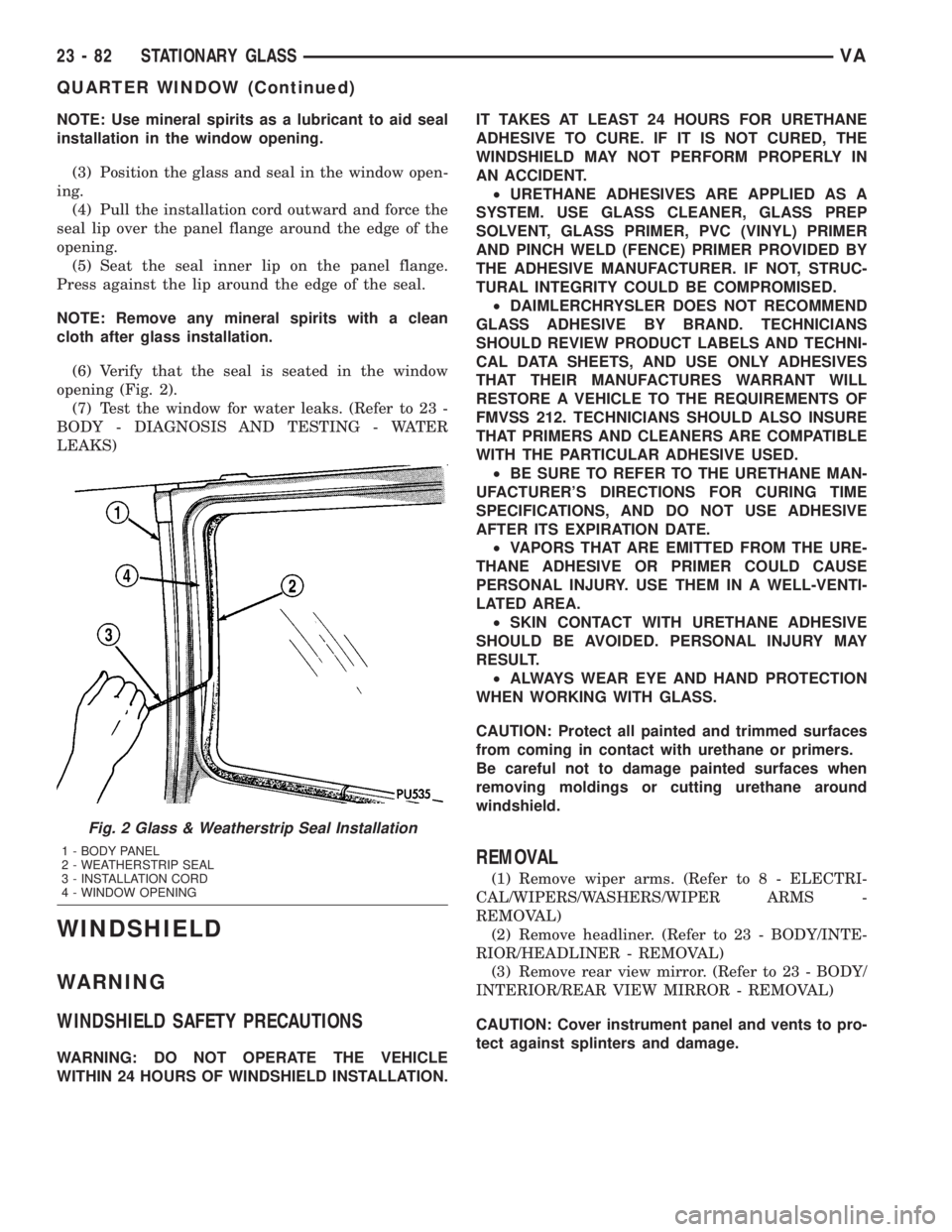
NOTE: Use mineral spirits as a lubricant to aid seal
installation in the window opening.
(3) Position the glass and seal in the window open-
ing.
(4) Pull the installation cord outward and force the
seal lip over the panel flange around the edge of the
opening.
(5) Seat the seal inner lip on the panel flange.
Press against the lip around the edge of the seal.
NOTE: Remove any mineral spirits with a clean
cloth after glass installation.
(6) Verify that the seal is seated in the window
opening (Fig. 2).
(7) Test the window for water leaks. (Refer to 23 -
BODY - DIAGNOSIS AND TESTING - WATER
LEAKS)
WINDSHIELD
WARNING
WINDSHIELD SAFETY PRECAUTIONS
WARNING: DO NOT OPERATE THE VEHICLE
WITHIN 24 HOURS OF WINDSHIELD INSTALLATION.IT TAKES AT LEAST 24 HOURS FOR URETHANE
ADHESIVE TO CURE. IF IT IS NOT CURED, THE
WINDSHIELD MAY NOT PERFORM PROPERLY IN
AN ACCIDENT.
²URETHANE ADHESIVES ARE APPLIED AS A
SYSTEM. USE GLASS CLEANER, GLASS PREP
SOLVENT, GLASS PRIMER, PVC (VINYL) PRIMER
AND PINCH WELD (FENCE) PRIMER PROVIDED BY
THE ADHESIVE MANUFACTURER. IF NOT, STRUC-
TURAL INTEGRITY COULD BE COMPROMISED.
²DAIMLERCHRYSLER DOES NOT RECOMMEND
GLASS ADHESIVE BY BRAND. TECHNICIANS
SHOULD REVIEW PRODUCT LABELS AND TECHNI-
CAL DATA SHEETS, AND USE ONLY ADHESIVES
THAT THEIR MANUFACTURES WARRANT WILL
RESTORE A VEHICLE TO THE REQUIREMENTS OF
FMVSS 212. TECHNICIANS SHOULD ALSO INSURE
THAT PRIMERS AND CLEANERS ARE COMPATIBLE
WITH THE PARTICULAR ADHESIVE USED.
²BE SURE TO REFER TO THE URETHANE MAN-
UFACTURER'S DIRECTIONS FOR CURING TIME
SPECIFICATIONS, AND DO NOT USE ADHESIVE
AFTER ITS EXPIRATION DATE.
²VAPORS THAT ARE EMITTED FROM THE URE-
THANE ADHESIVE OR PRIMER COULD CAUSE
PERSONAL INJURY. USE THEM IN A WELL-VENTI-
LATED AREA.
²SKIN CONTACT WITH URETHANE ADHESIVE
SHOULD BE AVOIDED. PERSONAL INJURY MAY
RESULT.
²ALWAYS WEAR EYE AND HAND PROTECTION
WHEN WORKING WITH GLASS.
CAUTION: Protect all painted and trimmed surfaces
from coming in contact with urethane or primers.
Be careful not to damage painted surfaces when
removing moldings or cutting urethane around
windshield.
REMOVAL
(1) Remove wiper arms. (Refer to 8 - ELECTRI-
CAL/WIPERS/WASHERS/WIPER ARMS -
REMOVAL)
(2) Remove headliner. (Refer to 23 - BODY/INTE-
RIOR/HEADLINER - REMOVAL)
(3) Remove rear view mirror. (Refer to 23 - BODY/
INTERIOR/REAR VIEW MIRROR - REMOVAL)
CAUTION: Cover instrument panel and vents to pro-
tect against splinters and damage.
Fig. 2 Glass & Weatherstrip Seal Installation
1 - BODY PANEL
2 - WEATHERSTRIP SEAL
3 - INSTALLATION CORD
4 - WINDOW OPENING
23 - 82 STATIONARY GLASSVA
QUARTER WINDOW (Continued)